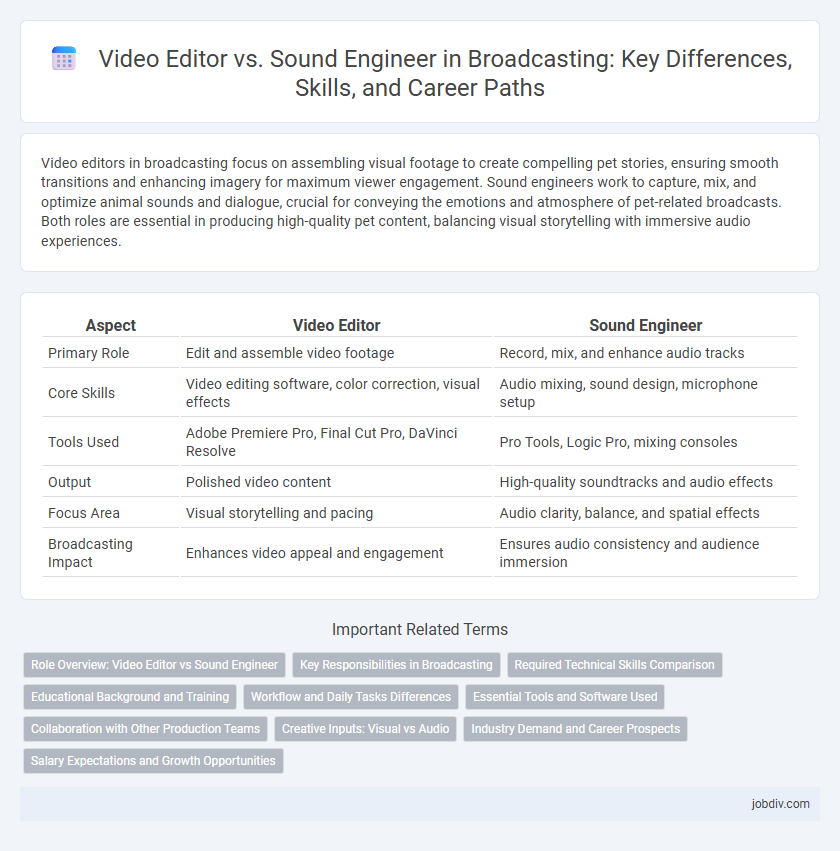Video editors in broadcasting focus on assembling visual footage to create compelling pet stories, ensuring smooth transitions and enhancing imagery for maximum viewer engagement. Sound engineers work to capture, mix, and optimize animal sounds and dialogue, crucial for conveying the emotions and atmosphere of pet-related broadcasts. Both roles are essential in producing high-quality pet content, balancing visual storytelling with immersive audio experiences.
Table of Comparison
| Aspect | Video Editor | Sound Engineer |
|---|---|---|
| Primary Role | Edit and assemble video footage | Record, mix, and enhance audio tracks |
| Core Skills | Video editing software, color correction, visual effects | Audio mixing, sound design, microphone setup |
| Tools Used | Adobe Premiere Pro, Final Cut Pro, DaVinci Resolve | Pro Tools, Logic Pro, mixing consoles |
| Output | Polished video content | High-quality soundtracks and audio effects |
| Focus Area | Visual storytelling and pacing | Audio clarity, balance, and spatial effects |
| Broadcasting Impact | Enhances video appeal and engagement | Ensures audio consistency and audience immersion |
Role Overview: Video Editor vs Sound Engineer
Video editors shape visual narratives by assembling raw footage, enhancing storytelling through cutting, transitions, and color correction to create polished final products for broadcasts. Sound engineers manage audio quality by recording, mixing, and balancing sound elements to ensure clear dialogue, music, and effects complement the video content seamlessly. Both roles are critical in broadcasting, with video editors focusing on visual impact and sound engineers prioritizing auditory experience to deliver engaging multimedia presentations.
Key Responsibilities in Broadcasting
Video editors in broadcasting are responsible for assembling raw footage, synchronizing audio and video, adding visual effects, and ensuring a coherent narrative flow to produce polished final content. Sound engineers focus on capturing, mixing, and enhancing audio quality during live broadcasts and post-production, managing equipment like microphones, mixers, and soundboards to maintain clear and balanced sound. Both roles collaborate closely to deliver seamless audiovisual experiences that meet broadcast standards and audience expectations.
Required Technical Skills Comparison
Video editors require advanced proficiency in editing software such as Adobe Premiere Pro, Final Cut Pro, and DaVinci Resolve, along with strong skills in color grading, motion graphics, and video compression techniques. Sound engineers must master audio mixing consoles, digital audio workstations like Pro Tools and Logic Pro, as well as sound design, acoustics, and noise reduction methods. Both roles demand a deep understanding of file formats, synchronization of audio and video, and troubleshooting technical issues to ensure high-quality broadcast production.
Educational Background and Training
Video editors typically hold degrees in film production, media arts, or digital communication, emphasizing expertise in video editing software like Adobe Premiere Pro and Final Cut Pro. Sound engineers often pursue education in audio production, acoustics, or music technology, with hands-on training in sound mixing consoles, microphones, and audio editing software such as Pro Tools and Logic Pro. Both professions require continuous technical training and mastery of industry-specific tools to stay current with evolving broadcasting standards and technologies.
Workflow and Daily Tasks Differences
Video editors primarily handle visual content by assembling raw footage, applying effects, and creating a cohesive narrative through editing software such as Adobe Premiere Pro or Final Cut Pro. Sound engineers focus on audio quality, managing recording setups, mixing tracks, and mastering sound using tools like Pro Tools or Logic Pro to enhance clarity and balance. While video editors emphasize visual storytelling and synchronization, sound engineers ensure optimal audio fidelity, resulting in distinct but complementary workflows within the broadcasting production process.
Essential Tools and Software Used
Video editors rely heavily on software like Adobe Premiere Pro, Final Cut Pro, and DaVinci Resolve to manipulate visual footage, apply effects, and ensure seamless transitions, while essential hardware includes high-resolution monitors and powerful graphics cards for efficient rendering. Sound engineers utilize digital audio workstations (DAWs) such as Pro Tools, Logic Pro, and Ableton Live, alongside audio interfaces, microphones, and mixing consoles to capture, edit, and balance audio tracks with precision. Both roles require specialized tools tailored to their medium, with video editors focusing on visual storytelling platforms and sound engineers specializing in audio production technology.
Collaboration with Other Production Teams
Video editors and sound engineers collaborate closely with camera operators, directors, and producers to synchronize visual elements with audio tracks, ensuring a cohesive broadcast production. Effective communication enables video editors to integrate sound effects, dialogue, and music seamlessly, while sound engineers adjust audio levels based on visual cues and scene transitions. This teamwork optimizes the final output's quality, enhancing viewer engagement and maintaining broadcast standards.
Creative Inputs: Visual vs Audio
Video editors shape storytelling through visual elements such as cuts, transitions, color grading, and motion graphics to enhance narrative impact. Sound engineers craft the audio experience by manipulating dialogue clarity, sound effects, ambient noise, and music mixing to create immersive auditory environments. Both roles require specialized creativity; editors focus on visual rhythm and composition, while sound engineers optimize tonal balance and spatial sound design.
Industry Demand and Career Prospects
Video editors and sound engineers both play critical roles in broadcasting, with demand for video editors rising due to the growth of digital content and streaming platforms. Sound engineers remain essential for producing high-quality audio in live broadcasts, podcasts, and film, maintaining steady career prospects. Industry trends indicate video editing skills are increasingly valued for multimedia storytelling, while sound engineering expertise supports evolving audio technologies and immersive experiences.
Salary Expectations and Growth Opportunities
Video editors in broadcasting typically earn a median salary ranging from $45,000 to $70,000 annually, with opportunities to advance into senior editing or post-production supervisor roles. Sound engineers command salaries between $40,000 and $75,000, benefiting from growth prospects in live event broadcasting and audio technology specialization. Both professions experience steady job growth driven by expanding digital content platforms and increasing demand for high-quality audiovisual production.
Video Editor vs Sound Engineer Infographic

 jobdiv.com
jobdiv.com